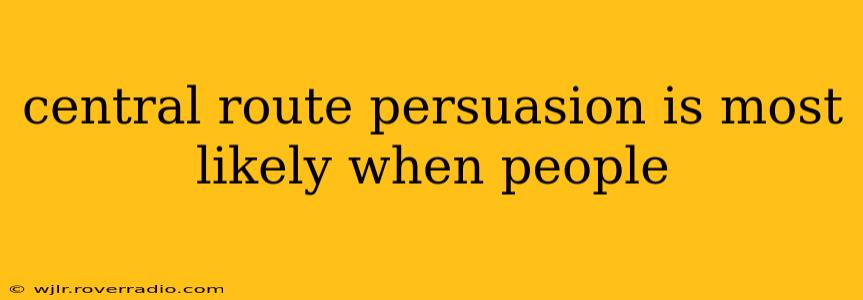Central Route Persuasion: When Logic and Reason Reign Supreme
Central route persuasion is a powerful method of influencing attitudes and behaviors, but it's not always the easiest path to take. Unlike the peripheral route, which relies on superficial cues and emotional appeals, the central route hinges on thoughtful consideration of the message itself. This means that the recipient actively processes the information presented, evaluating its logic, strength, and relevance. So, when are people most likely to be persuaded via the central route? Let's delve into the key factors.
Understanding Central Route Persuasion:
Before we explore the conditions, it's crucial to understand the core principles. Central route persuasion involves a high level of cognitive engagement. Individuals meticulously analyze the arguments, evidence, and reasoning presented to them, forming their opinions based on the merits of the information. This contrasts sharply with peripheral route persuasion, where quick judgments are made based on heuristics, emotions, or superficial factors like the speaker's attractiveness.
What motivates people to engage in central route processing?
This is a key question, and the answer lies in several factors:
1. High Motivation: People are more likely to engage in deep processing when they are highly motivated to understand the message. This motivation can stem from various sources:
- Personal relevance: If the message directly impacts their lives, their values, or their interests, they'll be more inclined to engage with it critically. For example, a student will likely pay close attention to an argument about tuition fees, whereas a person with no children might find a debate about school funding less compelling.
- Need for cognition: Individuals with a high need for cognition—a personality trait reflecting a preference for thinking and problem-solving—are more likely to engage in central route processing. They enjoy analyzing information and formulating their own opinions.
- Personal responsibility: If individuals feel personally responsible for the outcome of the decision, they'll carefully evaluate the information to make the best choice. For instance, a jury member will deeply consider the evidence presented before reaching a verdict.
2. High Ability: Even if motivated, people can only engage in central route processing if they have the cognitive ability to do so. This means:
- Sufficient knowledge: Having prior knowledge of the topic allows for more effective evaluation of the new information presented.
- Distraction-free environment: A quiet and focused environment free from distractions enables deep processing of information.
- Clear and understandable message: The message itself must be clear, well-organized, and easy to understand. Complicated or ambiguous messages can hinder deep processing.
H2: What if people lack motivation or ability?
If either motivation or ability is low, people are far more likely to rely on the peripheral route to persuasion. This involves relying on cues such as the speaker's credibility or attractiveness, the length of the message, or emotional appeals, rather than the message's content.
H2: What are some examples of central route persuasion in action?
A few compelling examples demonstrate the central route in action:
- A scientific study: A peer-reviewed study presenting detailed research and statistical analysis regarding the effectiveness of a new drug. The persuasiveness rests solely on the strength of the data and methodology.
- A political debate: When voters meticulously compare the policies and platforms of different candidates, analyzing their arguments and assessing their viability.
- A product review: A detailed and thorough review that meticulously describes a product's features, strengths, and weaknesses, supporting claims with evidence and offering comparisons.
H2: Is the central route always more effective?
While central route persuasion can lead to more enduring attitude change, it's not always the most effective strategy. It requires significant effort from both the persuader and the recipient. The peripheral route can be quicker and easier, even if the resulting attitude change is less lasting. The most effective persuasion strategy depends on the audience, the message, and the context.
In conclusion, central route persuasion is most likely to succeed when individuals are highly motivated and possess the cognitive ability to process the information presented. This involves careful consideration of the arguments, evidence, and reasoning presented, leading to enduring and well-reasoned attitudes and behavioral changes.
